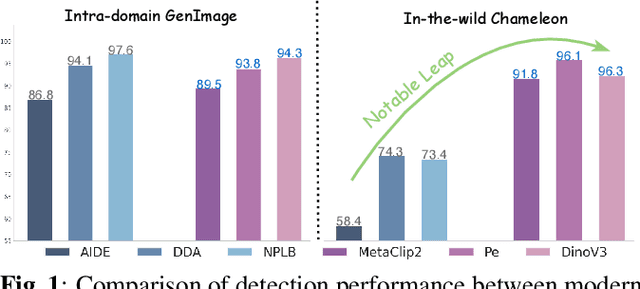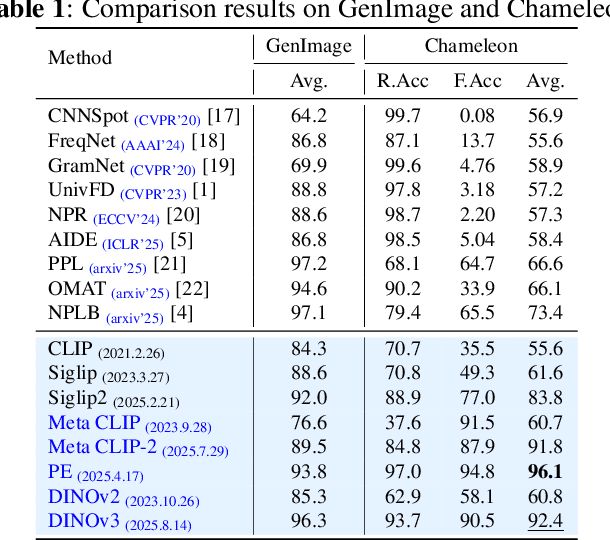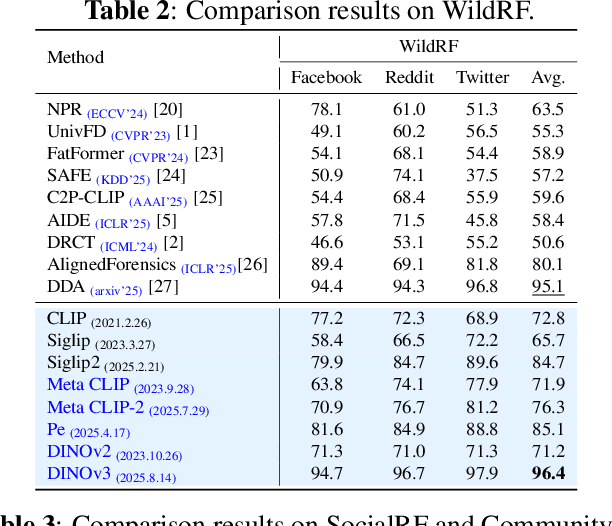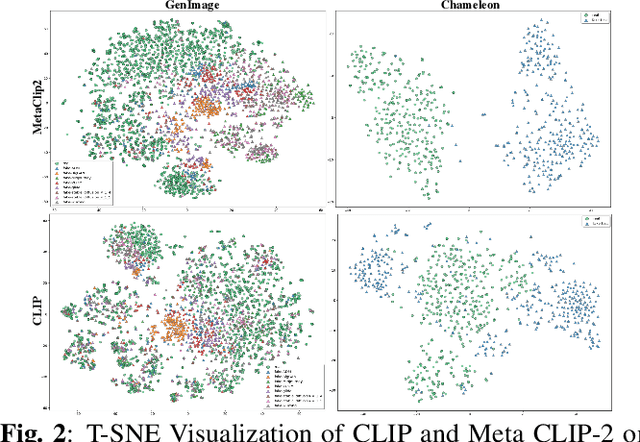Yue Zhou
Foundation Visual Encoders Are Secretly Few-Shot Anomaly Detectors
Oct 02, 2025Abstract:Few-shot anomaly detection streamlines and simplifies industrial safety inspection. However, limited samples make accurate differentiation between normal and abnormal features challenging, and even more so under category-agnostic conditions. Large-scale pre-training of foundation visual encoders has advanced many fields, as the enormous quantity of data helps to learn the general distribution of normal images. We observe that the anomaly amount in an image directly correlates with the difference in the learnt embeddings and utilize this to design a few-shot anomaly detector termed FoundAD. This is done by learning a nonlinear projection operator onto the natural image manifold. The simple operator acts as an effective tool for anomaly detection to characterize and identify out-of-distribution regions in an image. Extensive experiments show that our approach supports multi-class detection and achieves competitive performance while using substantially fewer parameters than prior methods. Backed up by evaluations with multiple foundation encoders, including fresh DINOv3, we believe this idea broadens the perspective on foundation features and advances the field of few-shot anomaly detection.
Brought a Gun to a Knife Fight: Modern VFM Baselines Outgun Specialized Detectors on In-the-Wild AI Image Detection
Sep 16, 2025



Abstract:While specialized detectors for AI-generated images excel on curated benchmarks, they fail catastrophically in real-world scenarios, as evidenced by their critically high false-negative rates on `in-the-wild' benchmarks. Instead of crafting another specialized `knife' for this problem, we bring a `gun' to the fight: a simple linear classifier on a modern Vision Foundation Model (VFM). Trained on identical data, this baseline decisively `outguns' bespoke detectors, boosting in-the-wild accuracy by a striking margin of over 20\%. Our analysis pinpoints the source of the VFM's `firepower': First, by probing text-image similarities, we find that recent VLMs (e.g., Perception Encoder, Meta CLIP2) have learned to align synthetic images with forgery-related concepts (e.g., `AI-generated'), unlike previous versions. Second, we speculate that this is due to data exposure, as both this alignment and overall accuracy plummet on a novel dataset scraped after the VFM's pre-training cut-off date, ensuring it was unseen during pre-training. Our findings yield two critical conclusions: 1) For the real-world `gunfight' of AI-generated image detection, the raw `firepower' of an updated VFM is far more effective than the `craftsmanship' of a static detector. 2) True generalization evaluation requires test data to be independent of the model's entire training history, including pre-training.
Broadband Near-Infrared Compressive Spectral Imaging System with Reflective Structure
Aug 20, 2025Abstract:Near-infrared (NIR) hyperspectral imaging has become a critical tool in modern analytical science. However, conventional NIR hyperspectral imaging systems face challenges including high cost, bulky instrumentation, and inefficient data collection. In this work, we demonstrate a broadband NIR compressive spectral imaging system that is capable of capturing hyperspectral data covering a broad spectral bandwidth ranging from 700 to 1600 nm. By segmenting wavelengths and designing specialized optical components, our design overcomes hardware spectral limitations to capture broadband data, while the reflective optical structure makes the system compact. This approach provides a novel technical solution for NIR hyperspectral imaging.
ConfProBench: A Confidence Evaluation Benchmark for MLLM-Based Process Judges
Aug 06, 2025Abstract:Reasoning is a critical capability of multimodal large language models (MLLMs) for solving complex multimodal tasks, and judging the correctness of reasoning steps is crucial for improving this capability. Recently, MLLM-based process judges (MPJs) have been widely used to assess the correctness of reasoning steps in multimodal tasks. Therefore, evaluating MPJs is important for identifying their limitations and guiding future improvements. However, existing benchmarks for MPJs mainly focus on tasks such as step correctness classification and reasoning process search, while overlooking a key aspect: whether the confidence scores produced by MPJs at the step level are reliable. To address this gap, we propose ConfProBench, the first comprehensive benchmark designed to systematically evaluate the reliability of step-level confidence scores generated by MPJs. Our benchmark constructs three types of adversarially perturbed reasoning steps: Synonym Substitution, Syntactic Transformation, and Image Perturbation, to test the robustness of MPJ confidence under perturbations. In addition, we introduce three novel evaluation metrics: Confidence Robustness Score (CRS), Confidence Sensitivity Score (CSS), and Confidence Calibration Score (CCS), which evaluate robustness, sensitivity, and calibration, respectively. We evaluate 14 state-of-the-art MLLMs, including both proprietary and open-source models. Experiments reveal limitations in current MPJs' confidence performance and offer competitive baselines to support future research.
Partial Weakly-Supervised Oriented Object Detection
Jul 03, 2025Abstract:The growing demand for oriented object detection (OOD) across various domains has driven significant research in this area. However, the high cost of dataset annotation remains a major concern. Current mainstream OOD algorithms can be mainly categorized into three types: (1) fully supervised methods using complete oriented bounding box (OBB) annotations, (2) semi-supervised methods using partial OBB annotations, and (3) weakly supervised methods using weak annotations such as horizontal boxes or points. However, these algorithms inevitably increase the cost of models in terms of annotation speed or annotation cost. To address this issue, we propose:(1) the first Partial Weakly-Supervised Oriented Object Detection (PWOOD) framework based on partially weak annotations (horizontal boxes or single points), which can efficiently leverage large amounts of unlabeled data, significantly outperforming weakly supervised algorithms trained with partially weak annotations, also offers a lower cost solution; (2) Orientation-and-Scale-aware Student (OS-Student) model capable of learning orientation and scale information with only a small amount of orientation-agnostic or scale-agnostic weak annotations; and (3) Class-Agnostic Pseudo-Label Filtering strategy (CPF) to reduce the model's sensitivity to static filtering thresholds. Comprehensive experiments on DOTA-v1.0/v1.5/v2.0 and DIOR datasets demonstrate that our PWOOD framework performs comparably to, or even surpasses, traditional semi-supervised algorithms.
UltraAD: Fine-Grained Ultrasound Anomaly Classification via Few-Shot CLIP Adaptation
Jun 24, 2025Abstract:Precise anomaly detection in medical images is critical for clinical decision-making. While recent unsupervised or semi-supervised anomaly detection methods trained on large-scale normal data show promising results, they lack fine-grained differentiation, such as benign vs. malignant tumors. Additionally, ultrasound (US) imaging is highly sensitive to devices and acquisition parameter variations, creating significant domain gaps in the resulting US images. To address these challenges, we propose UltraAD, a vision-language model (VLM)-based approach that leverages few-shot US examples for generalized anomaly localization and fine-grained classification. To enhance localization performance, the image-level token of query visual prototypes is first fused with learnable text embeddings. This image-informed prompt feature is then further integrated with patch-level tokens, refining local representations for improved accuracy. For fine-grained classification, a memory bank is constructed from few-shot image samples and corresponding text descriptions that capture anatomical and abnormality-specific features. During training, the stored text embeddings remain frozen, while image features are adapted to better align with medical data. UltraAD has been extensively evaluated on three breast US datasets, outperforming state-of-the-art methods in both lesion localization and fine-grained medical classification. The code will be released upon acceptance.
A Call for Collaborative Intelligence: Why Human-Agent Systems Should Precede AI Autonomy
Jun 11, 2025Abstract:Recent improvements in large language models (LLMs) have led many researchers to focus on building fully autonomous AI agents. This position paper questions whether this approach is the right path forward, as these autonomous systems still have problems with reliability, transparency, and understanding the actual requirements of human. We suggest a different approach: LLM-based Human-Agent Systems (LLM-HAS), where AI works with humans rather than replacing them. By keeping human involved to provide guidance, answer questions, and maintain control, these systems can be more trustworthy and adaptable. Looking at examples from healthcare, finance, and software development, we show how human-AI teamwork can handle complex tasks better than AI working alone. We also discuss the challenges of building these collaborative systems and offer practical solutions. This paper argues that progress in AI should not be measured by how independent systems become, but by how well they can work with humans. The most promising future for AI is not in systems that take over human roles, but in those that enhance human capabilities through meaningful partnership.
Guard Me If You Know Me: Protecting Specific Face-Identity from Deepfakes
May 26, 2025Abstract:Securing personal identity against deepfake attacks is increasingly critical in the digital age, especially for celebrities and political figures whose faces are easily accessible and frequently targeted. Most existing deepfake detection methods focus on general-purpose scenarios and often ignore the valuable prior knowledge of known facial identities, e.g., "VIP individuals" whose authentic facial data are already available. In this paper, we propose \textbf{VIPGuard}, a unified multimodal framework designed to capture fine-grained and comprehensive facial representations of a given identity, compare them against potentially fake or similar-looking faces, and reason over these comparisons to make accurate and explainable predictions. Specifically, our framework consists of three main stages. First, fine-tune a multimodal large language model (MLLM) to learn detailed and structural facial attributes. Second, we perform identity-level discriminative learning to enable the model to distinguish subtle differences between highly similar faces, including real and fake variations. Finally, we introduce user-specific customization, where we model the unique characteristics of the target face identity and perform semantic reasoning via MLLM to enable personalized and explainable deepfake detection. Our framework shows clear advantages over previous detection works, where traditional detectors mainly rely on low-level visual cues and provide no human-understandable explanations, while other MLLM-based models often lack a detailed understanding of specific face identities. To facilitate the evaluation of our method, we built a comprehensive identity-aware benchmark called \textbf{VIPBench} for personalized deepfake detection, involving the latest 7 face-swapping and 7 entire face synthesis techniques for generation.
Veracity Bias and Beyond: Uncovering LLMs' Hidden Beliefs in Problem-Solving Reasoning
May 22, 2025Abstract:Despite LLMs' explicit alignment against demographic stereotypes, they have been shown to exhibit biases under various social contexts. In this work, we find that LLMs exhibit concerning biases in how they associate solution veracity with demographics. Through experiments across five human value-aligned LLMs on mathematics, coding, commonsense, and writing problems, we reveal two forms of such veracity biases: Attribution Bias, where models disproportionately attribute correct solutions to certain demographic groups, and Evaluation Bias, where models' assessment of identical solutions varies based on perceived demographic authorship. Our results show pervasive biases: LLMs consistently attribute fewer correct solutions and more incorrect ones to African-American groups in math and coding, while Asian authorships are least preferred in writing evaluation. In additional studies, we show LLMs automatically assign racially stereotypical colors to demographic groups in visualization code, suggesting these biases are deeply embedded in models' reasoning processes. Our findings indicate that demographic bias extends beyond surface-level stereotypes and social context provocations, raising concerns about LLMs' deployment in educational and evaluation settings.
A Survey on Large Language Model based Human-Agent Systems
May 01, 2025Abstract:Recent advances in large language models (LLMs) have sparked growing interest in building fully autonomous agents. However, fully autonomous LLM-based agents still face significant challenges, including limited reliability due to hallucinations, difficulty in handling complex tasks, and substantial safety and ethical risks, all of which limit their feasibility and trustworthiness in real-world applications. To overcome these limitations, LLM-based human-agent systems (LLM-HAS) incorporate human-provided information, feedback, or control into the agent system to enhance system performance, reliability and safety. This paper provides the first comprehensive and structured survey of LLM-HAS. It clarifies fundamental concepts, systematically presents core components shaping these systems, including environment & profiling, human feedback, interaction types, orchestration and communication, explores emerging applications, and discusses unique challenges and opportunities. By consolidating current knowledge and offering a structured overview, we aim to foster further research and innovation in this rapidly evolving interdisciplinary field. Paper lists and resources are available at https://github.com/HenryPengZou/Awesome-LLM-Based-Human-Agent-System-Papers.
 Add to Chrome
Add to Chrome Add to Firefox
Add to Firefox Add to Edge
Add to Edge